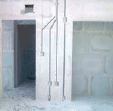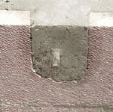| 1. |
Is E-Crete (AAC) a new product?
|
|
AAC has been used
in most European countries for more than 80 years
as well as in the Far and Middle East for the
past 40 years, and in Australia and South America
for over 20 years. AAC has been manufactured
and used in the US since the mid 90's. Structures
built over 75 years ago are still standing today
and continue to perform well and require little
maintenance.
|
| |
|
|
| 2. |
How has AAC been used? |
| |
AAC has been used worldwide in the
following applications:
Hospitality; hotels, motels and restaurants | Retail and
warehouses | Industrial | Office Buildings |
Education
Medical, clinics and offices | Religious | Single
family homes | Multi-family projects | Specialty
application such as fire walls and sound walls
|
| |
|
|
| 3. |
Why is AAC a good
thermal Insulator? |
|
Combining AAC's
R Value with 100% wall coverage thermal mass
inertia and low air infiltration results in a
wall system that has proven to reduce energy
in most applications. Click
here to view Thermal Table 13
|
| |
|
|
| 4. |
What is the "R" Value
that an 8" AAC wall produces? |
|
Depends on the
geographic area. In
Phoenix an 8" AAC wall produces an R-22 equivalent
value. Click
here to view a chart of R
Values by city.
|
| |
|
|
| 5. |
Why is a vapor barrier not required
in the exterior wall assembly of E-Crete AAC
wall? |
|
The enclosed cellular structure
of E-Crete along with the exterior finishes provides
the healthy balance between resistance to moisture
penetration and vapor diffusion. This balance
maintains a dry system, prevents moisture condensation
and allows vapor diffusion when and if any presence
of vapor occurs within the wall system.
|
| |
|
|
| 6. |
How and why is E-Crete considered
a Green Building Component? |
|
Autoclaved aerated concrete (AAC)
is well known as an environmentally friendly
construction material. The energy consumed in
the production process is only a fraction compared
to the production of other materials.The manufacturing
process emits no pollutants and creates no by-products
or toxic waste products.
E-Crete is manufactured from common and abundant natural raw materials.
The finished product is twice the volume of the raw materials
used, making it extremely resource-efficient and environmentally friendly.
|
| |
|
|
| 7. |
How much re-bar do you have to
use? |
|
In accordance with ICC Evaluation
Report 1371, reinforcement is required on the
corners and around the openings unless otherwise
specified by an engineer.
|
| |
|
|
| 8. |
How are plumbing and electrical
lines put in AAC walls? |
|
Chases are
routed or sawn in the AAC for the lines
and then patched with repair mortar or
polyurethane foam.
|

|
|
|
| 9. |
Is electrical conduit necessary
when using this product? |
|
Check with your local building
officials.
|
| |
|
|
| 10. |
Does E-Crete sell the mortar
for setting the AAC? |
|
Yes. E-Crete has a special polymer-modified
thin set mortar designed specifically for use
with AAC.
|
| |
|
|
| 11. |
What about the roof and trusses? |
|
Trusses
are attached using a top plate, anchor
or ledgers consistent with other wall
systems.
Ledgers are attached to J-bolts that are installed at the side
of the bond beam block with 4" concrete around the anchor bolt
filled to the face of the wall.
|

|
|



